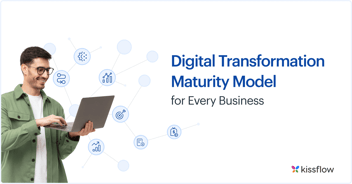
- >
- Digital Transformation >
- Crafting Your Digital Transformation Roadmap: A Comprehensive Guide
Crafting Your Digital Transformation Roadmap: A Comprehensive Guide
Team Kissflow
Updated on 16 Apr 2025 • 5 min read
Technology evolves rapidly, changing the business landscape and how organizations operate. Businesses that fail to adopt risk being left behind. Digital transformation enables businesses to stay competitive in an ever-changing marketplace, enhance operational efficiency, improve decision-making, and meet customer demands.
According to McKinsey, organizations that have undergone digital transformation are 26 percent more profitable than their peers. Integrating digital technologies leads to greater productivity, efficiency, and sustainability.
Many companies’ digital transformation initiatives are well underway. Research shows that 89 percent of all companies have adopted or plan to adopt a digital-first business strategy. Transformative technologies such as Artificial Intelligence (AI), cloud computing, and big data are now used across multiple industries.
IDG reports that the top industries for digital-first business strategies are services, financial services, and healthcare.
However, implementing digital solutions without a well-structured digital roadmap can cause delays in the adoption process—or complete failure. According to the Boston Consulting Group, 70 percent of digital transformation projects fall short of their goals.
Why a Well-Structured Roadmap Is Crucial in Digital Transformation?
A digital roadmap considers the specific pain points of an enterprise and outlines a course of action. It ensures that digital solutions align with the company's overall goals and objectives. Resources are allocated effectively, initiatives are prioritized, expenses are efficiently managed, and poor technology investments are avoided. Organizations with a well-defined digital roadmap will likely achieve their digital transformation goals.
A digital roadmap outlines the responsibilities of each department, boosting collaboration between stakeholders. Everyone works towards the same goal. Collaboration significantly enhances the implementation of digital solutions, making digital transformation successful.
A roadmap is also vital in helping enterprises stay ahead of the competition. They innovate and unlock new opportunities to create competitive advantages, grow revenue, and create value.
.webp?width=260&height=260&name=DT%20ebook%20(1).webp)
A common-sense Guide to Digital transformation
Get Traction, not hype
Thank you for downloading!
Key Components of a Digital Transformation Roadmap
Timeline
Define a timeline for each initiative in your digital transformation journey. Short, measurable phases allow for easy tracking. As you set timelines, consider resource constraints and dependencies. Don’t set deadlines that are impossible to reach.
Goals
Digital transformation goals include boosting revenue, improving time-to-market, increasing productivity, improving customer retention, and boosting competitiveness.
List the measurable and strategic goals your digital transformation will help achieve. Outline goals over the short-term and long-term and the digital solutions needed. Your roadmap for digital transformation should explain how the organization will mitigate risk while increasing profitability.
Stakeholders
When developing a digital roadmap, identify the key stakeholders each initiative will impact. Involving the stakeholders early on helps you build trust, ownership, and buy-in among them. It also ensures that your digital transformation strategy meets their needs and expectations.
Key Performance Indicators (KPIs)
Identify your core success metrics to judge each initiative's success or failure. While the KPIs will depend on your company's objectives, they can include higher conversion rates, better customer satisfaction scores, increased time-to-market for new products or features, and improved employee productivity.
Risks
Before implementing digital transformation, consider the risks associated with this complex process. Identifying the potential risks and coming up with solutions can help you overcome them. Build a contingency plan now; it could be a lifesaver later.
How to Align a Digital Roadmap with Business Goals
A digital transformation roadmap must align with business goals to fully exploit its potential. Transformation is a collaborative process, and everyone wins when goals and incentives are aligned. Before building a digital transformation roadmap, ensure you clearly understand your business goals and the digital capabilities you wish to acquire. List the specific goals you want to achieve, including milestones, timelines, budgets, and resources.
It’s also essential to monitor your digital transformation initiatives continually to ensure it remains aligned with your business users goals. Your digital roadmap will change as you acquire more information and get user feedback. Regularly measure and analyze the impact of your transformation initiatives and make the necessary adjustments.
A well-defined digital transformation roadmap optimizes resource allocation and expense management. It clearly outlines the project scope, helping a company identify initiatives performing well and mitigate issues such as duplication of efforts and cost overruns. An enterprise can also determine where to implement cost-cutting measures to ensure digital transformation projects stay on budget.
How to Create a Roadmap for Digital Transformation
1. Gather and Analyze Data
First, analyze the existing processes and systems. What’s working and what’s not? What can you improve? What are your digital transformation objectives? Gathering and analyzing data gives you a guideline to measure the effectiveness of your initiatives. For instance, if you’re hoping to improve employee productivity, determine the time they spend on specific tasks before adopting a new tool. During transformation, you can measure key performance indicators to see if the initiative is successful.
2. Get leadership buy-in
Get senior management on board to ensure they understand the core purpose of digital transformation and what it entails. Align their vision with your digital transformation roadmap from the very beginning. Explain how digitization will help the company achieve its goals and ROI.
Leaders can articulate the strategy and inspire employees to embrace change. Research shows that digital transformation efforts are 2.5 times more likely to be successful with senior leadership support. Without their commitment, any transformation is bound to fail.
3. Set realistic and measurable goals and objectives
Consider the goals and objectives for your digital transformation strategy, then break them into chunks to make the process more manageable. In each phase, work to achieve a specific goal. Afterward, regroup and assess your work to see if you’re still on track. If you’re not, make the necessary adjustments. Set S.M.A.R.T. goals—specific, measurable, achievable, relevant, and timely goals.
4. Create a transformation-ready culture
You may have gotten leadership buy-in for the initial launch, but you need to get everyone on board before any changes occur. Make employees understand the value of embracing digital transformation and new technologies. Communicate how a digital transformation will improve their efficiency and productivity.
Also, allow your team to share their concerns, opinions, and ideas on how to make digital transformation more effective. By involving employees in the digital transformation process, they will be less resistant to change.
5. Prioritize agility
Create a collaborative environment for implementing, assessing, and responding to change to build company-wide trust and collaboration. Create opportunities to regularly evaluate the roadmap and make adjustments according to your needs.
An agile digital roadmap ensures a high success rate by breaking digital transformation into sprints. After each milestone, you collect feedback from your team to determine what’s working and what needs improvement. By monitoring and reacting to real-time data, you can make adjustments iteratively, instead of pausing the entire transformation process.
How to Choose the Right Technology for Digital Transformation
Alignment with business goals
The technology you choose should contribute to your organization's strategic objectives. Aligning technology initiatives with business goals will enable your company to make strategic decisions that drive success.
Implementation timeline
Most companies take 12 to 18 months to implement digital transformations. Bigger companies may take one to two more years. The technology’s user-friendliness, leadership buy-in, and company culture are important for successful implementation. The tool you introduce shouldn’t be complex. They should be compatible with existing business systems and integrate easily with existing operations and processes. Any disruption of existing business activity during implementation should be tolerable.
Ease of use
Digital transformation is about making organizations faster and more agile in an ever-changing market. Speed and adaptability can only happen if an organization has well-integrated technology that’s easy to use.
Low-code/no-code tools support digital transformation, bridging business needs and technological capabilities. They empower employees to build their own solutions, accelerate innovation, drive efficiency, and foster a culture of continuous improvement.
Integration with existing technology
How easily can the new technology integrate with existing business systems? Will specialist help be needed for this integration?
A tool that easily integrates with existing business systems reduces redundancy and repetition, and allows for the reallocation of valuable resources to more critical tasks or areas of operation.
Scalability
The technology should allow employees to get more done faster with greater accuracy, opening the door to scalability. Scalable technology allows an organization to handle growth without sacrificing efficiency or productivity.
Kissflow: The key to successful digital transformation projects
In a constantly changing world, you need an agile and intuitive tool to make your digital transformation seamless. Kissflow can help you orchestrate a multi-faceted digital strategy toward the improvement of digital capacities of your organization.
The low-code/no-code platform enables users to create applications without writing code. With Kissflow's Digital transformation platform, you can implement digital transformation easily and achieve growth objectives faster and more efficiently.
To find out where you are in your transformation journey, use Kissflow’s digital transformation assessment tool. Understand how your company is currently using technology and where technology is not being used to its full potential.
Use Kissflow to become more agile and quickly meet enterprise business needs.

Choosing Your App-Development Stack: 11-Point Checklist
Related Articles











